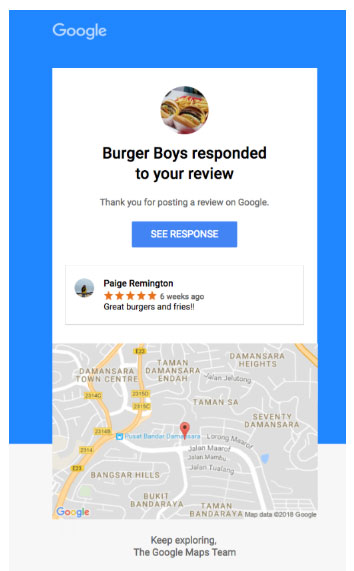Author: Miriam Ellis / Source: Moz

I’ve advocated the use of Google’s owner response review feature since it first rolled out in 2010. This vital vehicle defends brand reputation and revenue, offering companies a means of transforming dissatisfied consumers into satisfied ones, supporting retention so that less has to be spent on new customer acquisition. I consider review responses to be a core customer service responsibility. Yet, eight years into the existence of this feature, marketing forums are still filled with entry-level questions like:
- Should I respond to reviews?
- Should I respond to positive reviews?
- How should I respond to negative reviews?
Over the years, I’ve seen different local SEO consultants reply in differing degrees to these common threads, but as of May 11, 2018, both agencies and brands woke to a new day: the day on which Google announced it would be emailing notifications like this to consumers when a business responds to their reviews, prompting them to view the reply.

Surveys indicate that well over 50% of consumers already expect responses within days of reviewing a business. With Google’s rollout, we can assume that this numbers is about to rise.
Why is this noteworthy news? I’ll explain exactly that in this post, plus demo how Moz Local can be a significant help to owners and marketers in succeeding in this new environment.
When “extra” becomes “expected”
In the past, owner responses may have felt like something extra a business could do to improve management of its reputation. Perhaps a company you’re marketing has been making the effort to respond to negative reviews, at the very least, but you’ve let replying to positive reviews slide. Or maybe you respond to reviews when you can get around to it, with days or weeks transpiring between consumer feedback and brand reaction.
Google’s announcement is important for two key reasons:
1) It signals that Google is turning reviews into a truly interactive feature, in keeping with so much else they’ve rolled out to the Knowledge Panel in recent times. Like booking buttons and Google Questions & Answers, notifications of owner responses are Google’s latest step towards making Knowledge Panels transactional platforms instead of static data entities. Every new feature brings us that much closer to Google positioning itself between providers and patrons for as many transactional moments as possible.
2) It signals a major turning point in consumer expectations. In the past, reviewers have left responses from motives of “having their say,” whether that’s to praise a business, warn fellow consumers, or simply document their experiences.
Now, imagine a patron who writes a negative review of two different restaurants he dined at for Sunday lunch and dinner. On Monday, he opens his email to find a Google notification that Restaurant A has left an owner response sincerely apologizing and reasonably explaining why service was unusually slow that weekend, but that Restaurant B is meeting his complaint about a rude waiter with dead air.
“So, Restaurant A cares about me, and Restaurant B couldn’t care less,” the consumer is left to conclude, creating an emotional memory that could inform whether he’s ever willing to give either business a second chance in the future.
Just one experience of receiving an owner response notification will set the rules of the game from here on out, making all future businesses that fail to respond seem inaccessible, neglectful, and even uncaring. It’s the difference between reviewers narrating their experiences from random motives, and leaving feedback with the expectation of being heard and answered.
I will go so far as to predict that Google’s announcement ups the game for all review platforms, because it will make owner responses to consumer sentiment an expected, rather than extra, effort.
The burden is on brands
Because no intelligent business would believe it can succeed in modern commerce while appearing unreachable or unconcerned, Google’s announcement calls for a priority shift. For brands large and small, it may not be an easy one, but it should look something like this:
- Negative reviews are now direct cries for help to our business; we will respond with whatever help we can give within X number of hours or days upon receipt
- Positive reviews are now thank-you notes directly to our company; we will respond with gratitude within X number of hours or days upon receipt
Defining X is going to have to depend on the resources of your organization, but…
Audience Team
The digital audience insights you need to build, manage and market to your digital audiences.

